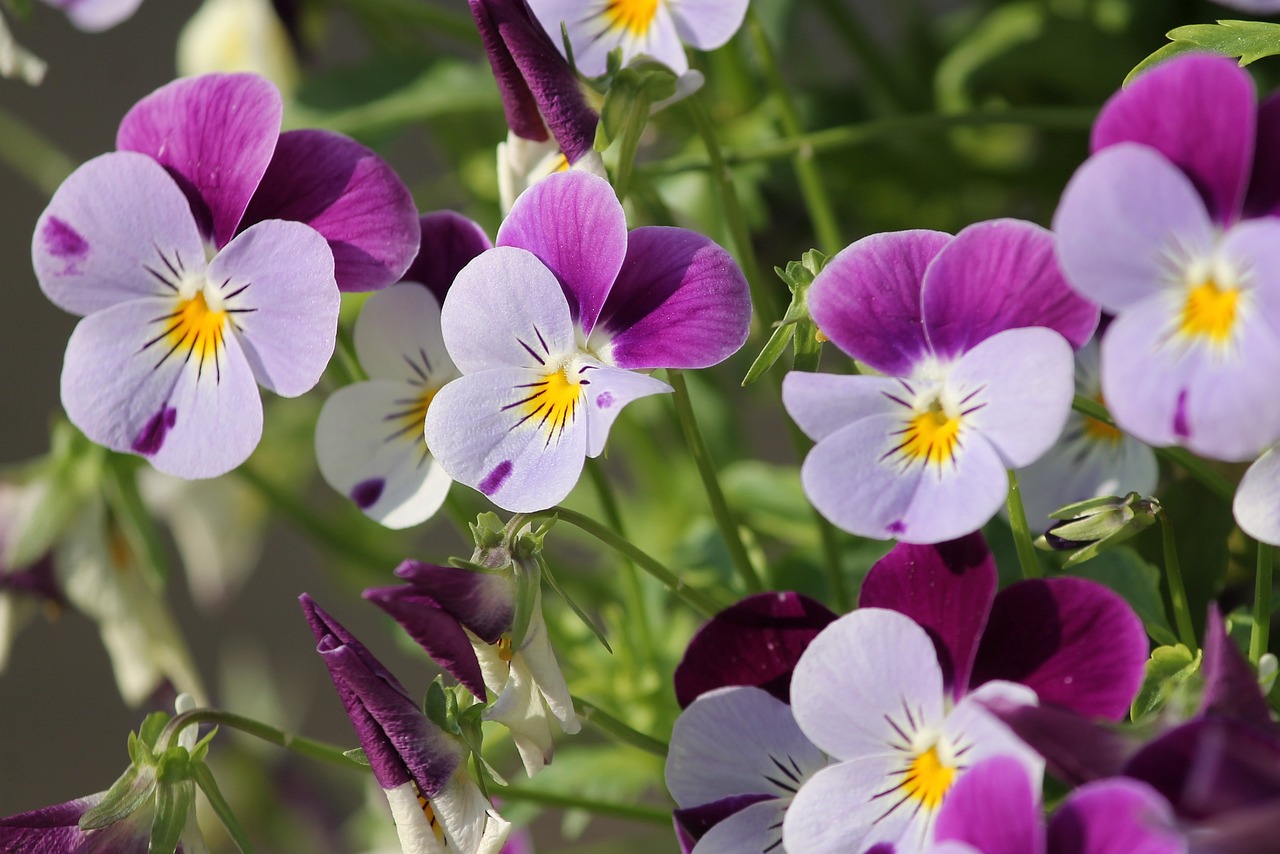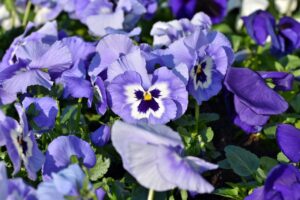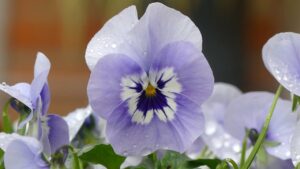Pansy
Overview
The Viola × wittrockiana, commonly known as the Pansy, is a hybrid plant celebrated for its vivid, multi-colored flowers. Belonging to the Violaceae family, Pansies are predominantly grown for their ornamental charm, showcasing large, heart-shaped petals. These cheerful blooms prefer mild climates and can offer year-round color in certain regions.
Botanical Information
The Pansy (Viola × wittrockiana) is a member of the violet family, known for its bright and variegated face-like flowers. A hybrid of several species within the Viola genus, Pansies stand out with their delightful range of colors and patterns.
Growing Conditions
Pansies thrive in mild climates and can grow in a variety of European landscapes. They flourish under full sun to semi-shaded conditions and favor well-drained soils.
Uses and Benefits
Valued for their decorative appeal, Pansies provide charming heart-shaped petals and lively hues for containers, borders, and garden beds.
Cultivation Tips
To grow healthy Pansies, mimic their natural habitat with adequate sunlight, semi-shade, and proper drainage.
Seasonal Considerations
While adaptable, Pansies prefer cool seasons and are ideal for planting in the early or late parts of the gardening calendar.
Companion Planting
Specific companions for planting with Pansies are not noted in the available research.
Common Issues
Pansies can face typical plant challenges like pests and diseases, but specific issues relevant to them have not been provided.
History and Folklore
There is no information available on the history or folklore of the Pansy in the cited sources.

Characteristics
Known for their charming, face-like blooms in a variety of vibrant colors and patterns, and widely used for ornamental purposes in gardens.
Region
Pansies are commonly found and grown throughout most of Europe in dry meadows, fields, and roadside areas.
Natural Habitat
In the wild, it is typically found in dry meadows, fields, and along roadsides.
Cultivation
Prefers full sun to semi-shade, moderate watering, and well-drained soil.
Uses and Benefits
Pansies are more than just a pretty face in the garden. They also hold various benefits aside from their ornamental glory.
- Aesthetic Appeal: With their vivid colors and unique patterns, pansies provide an instant lift to garden beds, borders, and containers.
- Year-Round Color: In mild climates, pansies can offer bursts of color throughout the year, keeping gardens lively even when other plants are dormant.
- Versatility: Pansies can thrive in both sunny and semi-shade areas, making them adaptable to different garden spots.
- Ease of Cultivation: Their ability to grow in various conditions and their fast-growing nature make pansies a rewarding choice for gardeners of all levels.
These benefits demonstrate why pansies, or Viola × wittrockiana, are cherished by those who seek continuous vibrancy and life in their gardens.

Cultivation Tips
Growing Viola × wittrockiana successfully requires simulating its natural conditions for optimal health and bloom. Below are key cultivation tips to ensure vibrant Pansy flowers:
- Location: Choose a sunny or semi-shaded spot, mimicking the Pansy’s preference in its natural European habitats.
- Soil: Ensure the planting medium is well-drained. Pansies thrive in loamy soil that’s moderately fertile.
- Planting Time: Cool weather is ideal for Pansies. Plant them in early spring or fall for the best growth.
- Watering: Regular watering helps maintain moist soil, but avoid waterlogging as it can harm the plants.
- Fertilization: Apply a balanced, slow-release fertilizer to nourish the plants without overwhelming them.
- Grooming: Remove faded or dead flowers to encourage new blooms and maintain plant vigor.
- Pest Management: Monitor for common pests and address any infestations promptly to keep the plants healthy.
Remember, although Pansies are robust, regular monitoring and care will help prevent and mitigate common issues like pests and diseases. Following these guidelines will help you to cultivate healthy Pansies that can brighten your garden with their delightful array
Seasonal Considerations
When considering the seasonal needs of the Viola × wittrockiana, or Pansy:
- Spring Planting: Ideal for vibrant spring blooms. Pansies thrive in the cooler temperatures of this season.
- Autumn Consideration: For regions with mild winters, planting in the fall can lead to overwintering and early spring color.
- Summer and Winter: Generally avoided due to extreme heat or cold, which pansies may not tolerate well.
For the best results, choose early and late seasons when temperatures are more likely to be Pansy-friendly. With careful planning, these charming flowers can adorn your space throughout various parts of the year4.

Issues and Troubleshooting
- Pansies, or Viola × wittrockiana, may encounter pests like aphids and slugs.
Monitoring the plants regularly can help catch these issues early. - Overwatering can lead to root rot.
Ensure well-drained soil and be careful not to water excessively. - Powdery mildew is another concern, especially in damp conditions.
Good air circulation and avoiding water on the foliage can prevent this. - Fungal diseases such as leaf spot can be mitigated by removing affected leaves and improving soil conditions.
History and Folklore
The Pansy, with its scientific name Viola × wittrockiana, carries a storied past and fascinating folklore. Originating from the wildflower V. tricolor, the Pansy has roots deeply embedded in Europe and Western Asia1. Over the centuries, Pansies were often associated with thoughtfulness and remembrance, likely inspired by their distinctive “faces”. In Shakespeare’s “A Midsummer Night’s Dream,” the flower is a symbol of love, as its juice is used as a love potion. During the Victorian era, the Pansy became a secret language of lovers, where giving a Pansy meant “think of me” due to its name derived from the French ‘pensée’, meaning ‘thought’. This rich tapestry of symbolism has cemented the Pansy in cultural lore as a bearer of emotions and a whisperer of silent messages.
References
1. Pansy – Wikipedia, https://en.wikipedia.org/wiki/Pansy
2. Pansies: How to Grow and Care with Success – Gardenia, https://www.gardenia.net/guide/pansies-plant-care-and-growing-guide
3. Pansy: Botanical Profile of a plant – Weleda, https://www.weleda.com.au/magazine/nature/botanical-profile-pansy
4. How to Grow and Care for Pansies – The Spruce, https://www.thespruce.com/pansies-growing-a-cool-weather-favorite-1402913
5. Growing Pansies: How to Plant, Grow, and Care for Pansy Flowers: The …, https://www.almanac.com/plant/pansies
Image Credit: manfredrichter
Image Credit: Ralphs_Fotos
Image Credit: morten2good
Nicolas Duval
Nicolas is a passionate advocate for nature and the art of wildcrafting. His dedication shines through in Wildcraftia, a website he meticulously crafted to serve as a haven for nature enthusiasts worldwide. Driven by a deep appreciation for nature’s connection to humanity, Nicolas embarked on his journey in 2011 with SmokableHerbs, a platform showcasing his love for nature’s bounty. Building upon this foundation, he established Smokably, a thriving online store offering premium herbs and blends to a global audience.
